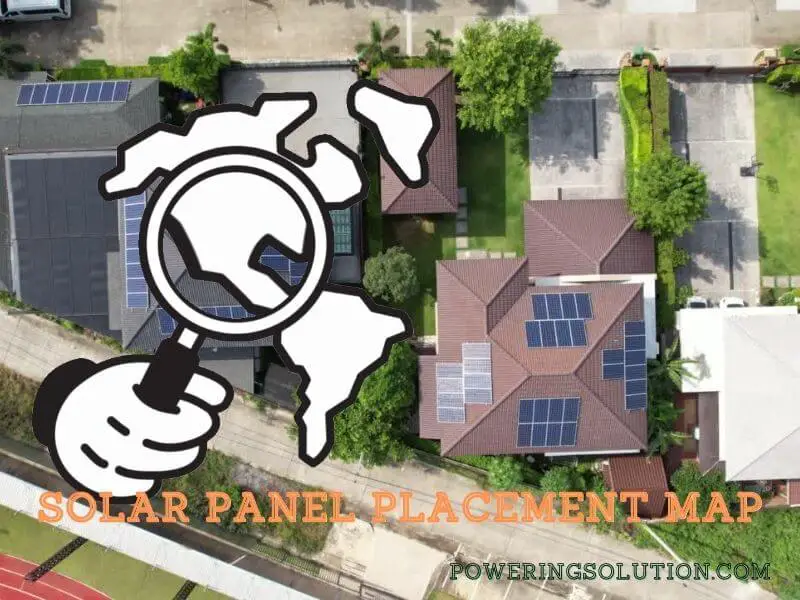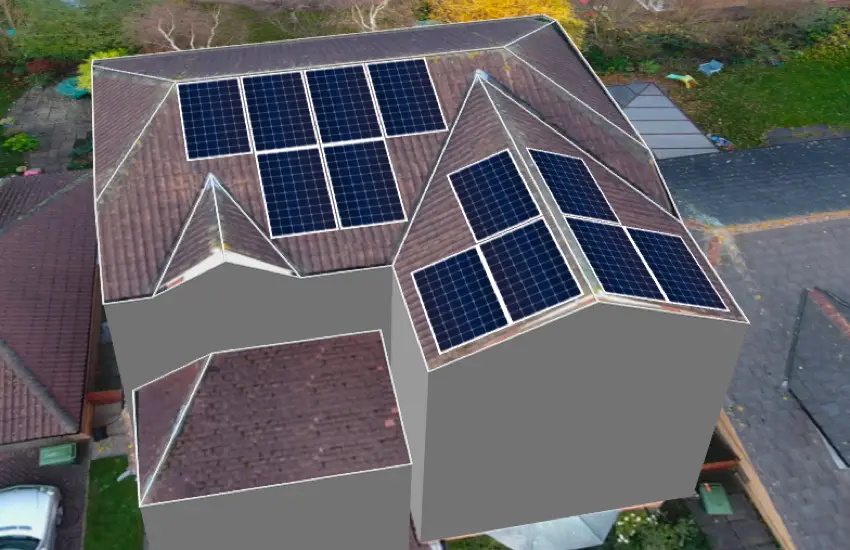If you’re wondering where to place your solar panels, this solar panel placement map can help. Solar panels should be sunny, preferably on the south-facing roof. The sun’s angle changes throughout the year, so adjusting the solar panel accordingly is important.

In the Northern Hemisphere, the sun is highest in the sky in June and lowest in December. So, if you live in the Northern Hemisphere, you’ll want to tilt your solar panels towards the south by about 30 degrees in June and 15 degrees in December.
If you want to catch more about solar panel maps and instalments, keep reading the article.
Solar Potential Map by Address
The Solar Potential Map by Address is a tool that allows you to input your address and find out the potential for solar energy production at your location. The National Renewable Energy Laboratory (NREL) created the map and provided data on rooftops across the United States. The map is based on several factors, including roof size, orientation, tilt, and shading.
It also takes into account the average monthly solar insolation for each state. This is the amount of sunlight that hits a given area in a month and is a key factor in determining how much solar energy can be produced. To use the map, enter your address into the search bar.
The map will then show you the potential for solar energy production at your location. If you click on any of the blue dots, you’ll see more detailed information about that particular site, including its estimated annual solar output (kilowatt-hours). If you’re interested in installing solar panels at your home or business, this map is a great place to start.
It can help you determine if there’s enough sun exposure at your location to make PV installation worthwhile. And if there is, it can also give you an idea of what kind of system size you’ll need to meet your electricity needs.
Solar Panel Mapping Tool
A few options are available if you’re looking for a solar panel mapping tool. Google Maps is one option that can be used to find solar panels in your area. Another option is the Solar Panel Finder website, which provides a searchable database of solar panel locations.
Google Sunroof
Google Sunroof is a free online tool that shows you how much solar energy is available for your home. It uses Google Maps to estimate the sunlight that hits your roof and calculates the potential savings you could earn by installing solar panels.
The sunroof is currently available in select U.S. states (Arizona, California, Colorado, Connecticut, Delaware, Hawaii, Maryland, Massachusetts, Nevada, New Hampshire, New Jersey, New Mexico, New York, Oregon, Pennsylvania, Rhode Island, South Carolina, Utah, Vermont and Washington) plus the District of Columbia.
To use Sunroof:
| Go to google.com/sunroof> | Enter your address>. | See how much sun hits your roof |
Project Sunroof
In 2015, Google launched Project Sunroof, an online tool that uses data from Google Maps to estimate the solar potential of a given address. The tool provides data on the sunlight that hits a given location and the average cost of installing solar panels. It also offers financing options and links to local solar installers.
Project Sunroof is available in select cities across the United States. In each city, users can enter their addresses to estimate how much sunlight their roof receives each year and how much money they could save by installing solar panels. The tool also provides information on the average cost of installing solar panels in that city and links to local solar installers.
Project Sunroof is designed to make it easier for people to go solar by providing all the information they need in one place. Making solar more accessible and affordable can help move the world closer to a clean energy future.
Solar Panels
If you’re considering solar panels for your home, you should know a few things. Solar panels are a great way to save money on your energy bill and are also good for the environment. There are a few things to consider before you make the switch:
| The solar panel is expensive | The initial cost of installation can be upwards of $10,000. Many incentives and rebates available can help offset the cost. |
| It is long-lasting | Solar panels typically have a 20-25 year lifespan, saving you money in the long run. |
| Requires less maintenance after installation | Solar panels also require little maintenance once they’re installed. They should be cleaned every few months to remove any dirt or debris that could reduce their efficiency. You can use a simple green cleaner to clean solar panels. |
| The solar panel has both advantages and disadvantages | Solar panels work best in sunny climates. If you live in an area with lots of clouds and rain, you may not get as much benefit from them as someone who lives in a sunny area. Even if your climate isn’t ideal for solar panels, they can still provide some savings on your energy bill. |
Google Sunroof API
In 2015, Google launched Project Sunroof, an initiative that uses Google Maps data to help people see how much money they could save by installing solar panels in their homes. The project is now open to everyone in the US, and the team has just released an API so developers can access Sunroof’s data and build new apps with it.
The Sunroof API gives developers access to three years of high-resolution aerial imagery for the contiguous United States and cloud cover data from Weather Underground.
With this data, developers can estimate the amount of sunlight that hits a given location during the course of a year and calculate the potential savings from installing solar panels.
The release of the Sunroof API comes at a time when interest in solar power is growing rapidly. In 2016, residential solar installations in the US grew 95% compared to the previous year, and there are now more than 1 million homes with rooftop solar panels.
Where Should Solar Panels Be Positioned?

Solar panels must be positioned in a sunny location – ideally south-facing – and at a suitable angle. The angle depends on your latitude:
- You’ll need a steeper angle if you’re closer to the equator.
- Whereas a shallower angle will suffice if you’re further away.
Once you know where your solar panels should go, it’s important to consider the practicalities too. If trees or other buildings shade your roof, that will not be a good spot for solar panels. And if there’s any chance that panels could be obstructed by future developments (e.g. new construction next door), that’s something else to bear in mind.
In short, the best position for solar panels is in a sunny spot with no shading or obstructions at an angle that maximizes exposure to the sun throughout the year. Otherwise, you will have to take precautions to save it from rain.
Frequently Asked Question
How Can I Use the Solar Panel Placement Map to Determine the Best Orientation for Solar Panels in the Southern Hemisphere?
To determine the optimal solar panel orientation in the Southern Hemisphere, use the solar panel placement map. Consider the direction of the sun’s path and ensure panels face north for maximum sunlight exposure. Adjust the tilt angle based on location for optimal energy production.
Solar Potential Map
The Solar Potential Map is a tool that allows users to estimate the potential solar energy production of a given location. The map considers various factors, such as the sun’s angle, the amount of daylight, and cloud cover. The map can be used to estimate the amount of electricity that could be generated by a photovoltaic system at a given location.
It can also calculate the number of square feet required for a solar array to meet specific electricity needs. The Potential solar Map is available for free online.
Do Solar Panels Need to Face South?
No, solar panels do not need to face south. In the Northern Hemisphere, they should face towards the south to maximize sunlight exposure during the day. In the Southern Hemisphere, they should face north.
Solar panels can also be mounted on a roof or the ground.
Google Solar Map
Google’s Solar Map is a free online tool that shows you the potential for solar power at your home or business. Just enter your address, and Google will show you a map of your area with the potential for solar panels. The map takes into account the amount of sunlight that hits your location, as well as the angle of your roof.
You can also use the map to determine how much money you could save by installing solar panels.
Design Solar Panels on Google Maps
Wrap Up
The first step in planning a solar panel system is determining the best placement for the panels. The sunlight that hits a particular location varies throughout the year, so it’s important to consider this when choosing where to place your panels. A few online tools can help you determine the best placement for your solar panels.
One of these is the Solar Panel Placement Map, which shows how much sunlight hits different locations throughout the year. The Solar Panel Placement Map is a great tool for anyone considering installing a solar panel system. It can help you determine the best placement for your panels and ensure you get the most out of your investment.
Read More:
